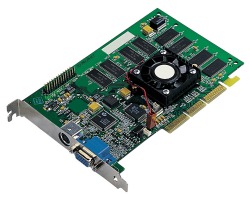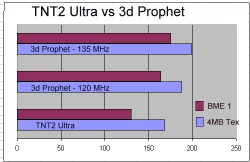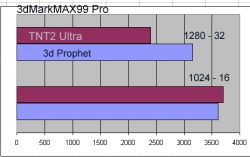|
Guillemot 3d Prophet
by Leonard "Viking1" Hjalmarson |
||||
|
With the first boards based on Nvidia's new GeForce 256 chip hitting the streets we enter a new era of video acceleration, promising increased image detail at increased resolutions. Ten days ago I installed Guillemot's 3d Prophet in my PII 450 system, and then also tested the board in an Athlon 600 MHz system. The results are predictable based on other results around the net, with games like WW2 Fighters showing virtually no difference in frame rate at 1024x768, but higher resolutions and synthetic benchmarks revealing at least some of the potential of this new technology.
 Behold the Board The board itself is virtually identical to any TNT2 board. The memory layout is the same layout and speed at Guillemot's MaxiGamer Xentor 32. The chip itself is the same size as the TNT2, the only difference being the heatsink and fan are slightly larger. I benched the 3d Prophet using three measures: WW2 Fighters in-game test, an F4 TE mission, and the Expendable Timedemo, and 3dMarkMax99 Pro. I had no errors in any tests, and even when overclocking from 120 MHz to 135 MHz. The chip seemed warm to the touch at its stock speed, but became as hot as the Matrox G400 MAX when pushed to 135 MHz. Vital Statistics and Installation The 3d Prophet has 5.5ns Vanguard memory and the memory speed default is 166MHz. I clocked the memory to 180 without any difficulty or errors. Installation was a simple matter using the install CD provided. I followed the standard routine of un-installing my TNT2 board, going to a generic VGA driver and then rebooting with the new hardware in place. The driver CD included used 3.47 drivers, but the next day the new 3.53 drivers were released. The new drivers gave a speed gain averaging around 5%, but as high as 10% when loading large textures. I used the latest version of Powerstrip (3.53) for overclocking and then also tried the built-in overclocking ability in the new drivers. |
 Compatability and Benchmarks Initial tests under EAW, MiG Alley, Falcon 4.0 and WW2 Fighters produced no problems with the exception of Falcon 4, which refused to run with the initial installation. Thankfully, the newest driver revision solved that issue. All tests were run on a recent WIN98 OSR2 installation. All apps in SYSTRAY were closed and the hard drive was defragmented prior to installing the board and drivers. The TNT2 Ultra was run under Detonator drivers v. 2.08. 3dMarkMAX99 is a recent benchmark product developed by Futuremark Corporation. The diagnostic suite analyzes, tests and reports a system's 3D performance. A balanced testing methodology includes image quality, rendering speed, CPU capability and an Internet information base. The suite of tests is large and varied and includes realtime 3d demo applications. 1024x768, 16 bit Running the 3d game tests at 1024x768 and 16 bit color, the boards scored virtually equal, with Game Race 1 test being identical and Game Race 2 test taken by the 3d Prophet, which scored 5% faster than the TNT2 Ultra, a result that was later borne out by my in-game tests in WW2 Fighters. At 1280x1024 and 32 bit color, however, the 3d Prophet outperformed the TNT2 Ultra by 25-40%.
 At 1024x768 and 16 bit color the 3d Prophet scored 3610 in 3dMarkMAX99. The MaxiGamer Xentor 32 scored 3703 3DMarks. When moving to higher resolution and 32 bit color, however, tables were turned, with the 3d Prophet scoring 3150 3DMarks to the TNT2 Ultra's 2399. The texture rendering speed tells a similar story. Rendering a 4MB texture the TNT2 Ultra board scored 168.4 fps. The 3d Prophet scored 187.7 fps. Rendering a 16 MB texture the scores were 68 and 82 respectively (see chart at top of page.)
Go to Part II
|
|||
|
Copyright © 1997 - 2000 COMBATSIM.COM, INC. All Rights Reserved. Last Updated November 1st, 1999 |
||||
